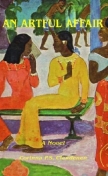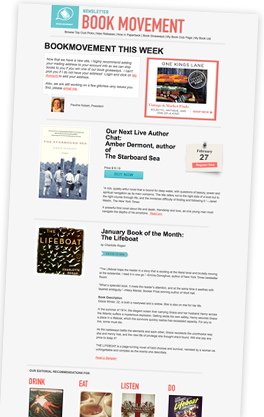BKMT READING GUIDES
An Artful Affair
by Corinna P. S. Clendenen
Paperback : 368 pages
0 club reading this now
0 members have read this book
All ...
Introduction
A painter, an auctioneer and an art critic are embroiled in a love triangle, forgeries and ambition gone awry in An Artful Affair. Set in 1977, this suspenseful New York story of three young people trying to make it in Manhattan reveals the eternal conflicts between art and money.
All Bo Ryder ever wanted was to paint in peace. But when his landlord serves him an eviction notice, the impoverished painter is forced to make compromises. Forgery wasn’t exactly a sideline he had planned on. Nor was falling for art world reporter Megan Trico, who knows only that the talented but unrecognized Bo has exclusive rights to her heart. But when Bo’s attentions falter while she is investigating a Nazi-looted painting sold through Sotheby’s, she is sidetracked by the rival auction house expert, Alastair Cavendish. Determined to prove himself with a record-breaking Modern Painting sale, Alastair is thrown off course by the beautiful young reporter Megan—in more ways than one.
A major character in the novel is the art world itself in all its bubbling, broiling turmoil of talent and dreams, fame and fortune. Art auctions, ever setting new highs for cultural icons, be they Andy Warhol's soup cans or Faberge Eggs, include a colorful cast of characters from society hostesses to the shyest esthetes. With vivid visual descriptions of art and locale, An Artful Affair paints an authentic picture of the full spectrum of the New York art world.
From Soho’s grungy studios to the Upper East Side’s glittering galleries, Megan traverses Alastair and Bo’s turfs, her investigations bringing their star-crossed paths ever closer. Involved with both men without each other's knowledge, Megan becomes the fulcrum in a triangle love affair, caught between opposing worlds and unable to decide which she would rather inhabit. As events take on a life of their own, she loses her chance to choose.
"A highly entertaining and engrossing tale that accurately explores the intrigues and truths of the art world. The writer's passion for her subject, and her years of work in the art market, are clearly evident in this excellent novel." - Harmer Johnson, former Sotheby’s Director
Excerpt
Prologue to An Artful AffairIt wasn't so much the graffiti in the cell that troubled Bo, but that it brought to mind the work of a painter he particularly disliked. When his weary eyes glazed over, the scrawl of jumbled names and expletives blurred, forming a random but intricate pattern on the solid wall of institutional green. It looked just like the abstract chicken scratchings of Cy Twombly. And for this reason he decided halfway through his first night behind bars that it must be his last. ...
Discussion Questions
No discussion questions at this time.Notes From the Author to the Bookclub
Questions from Corinna Clendenen: How and why does Bo succumb to Gerhardt’s temptations? Discuss the various stages of Bo’s fall. What finally motivates Bo to sign the name of the forged artist to the forgery? Discuss Bo’s ethical dilemma. Is he justified in his actions? Does your opinion of him change over the course of the novel? How does forging masterpieces effect his conscience? Why does he mis-date the Gauguin forgery? What does the imagery associated with Megan convey—her enormous bag, her mis-matched earrings, her inability to decide on a neighborhood to live in? How does this change by the end of the novel? What differences between English and American society pose problems for Alastair? Discuss how the characters’ positions vary relative to each other, i.e. how is Megan viewed by Colin? By Bo? How is Bo viewed by Paddy? By Megan? How does Megan view Alastair? How does the boardroom lunch alter her view of him? Discuss Megan’s sacrifice of her final newspaper story in the Gerhardt investigation. Which character has the most integrity? Why is Catherine DuBois unable to see Reinhold Gerhardt as anything other than her knowledgeable friend? What role does social position play in the art world? Why is it important? What is the importance of time in the novel? How does Bo and Alastair’s sense of time differ? What images are used to convey this? What is the significance of timing to Bo’s art? In light of the recent scandal over collaborative price-fixing between Sotheby’s and Christie’s, should auction sales be under closer inspection or official regulation? What are the risks of buying in the international art market? Should the countries of origin of the artwork have jurisdiction over what happens to that artwork in another country? Should art confiscated by the Nazis be returned to the heirs of the original owner even if the present owner has bought the art through legitimate channels? How and why do the auction houses cater to the wealthy? In 1971 a zoning law was passed restricting residency in Soho to working artists, producing a heyday of galleries and studios. Gradually, variances were granted to non-artists, changing the residents, and by the mid-80s the condo boom served to price many artists out of Soho. Should these neighborhoods be preserved to allow for the cultural flowering that occurs in a longstanding art community? Is Alastair justified in his judgment of Megan when he discovers she has been Bo’s girlfriend? Which man is Megan better suited for and why? How can two such very different men belong equally to the art world? Once an artist sells a work, should he or she retain rights to it, financial or otherwise? Should an artist share in the profits if the artwork is sold by a later seller for a much greater price than the artist originally sold it for (i.e. as with De Kooning)? Does the owner of an artwork (arguably part of a culture) have the right to destroy the piece? Modigliani forgeries by Elmyr DeHory have been exhibited in galleries and sold as declared fakes. Is this a case of glorifying a shyster celebrity or do these forgeries have merit of their own? What is the price of an artwork based on? If a forgery gives as much pleasure to the viewer as what it’s supposed to be, does it matter if it isn’t?Book Club Recommendations
Recommended to book clubs by 0 of 0 members.
Book Club HQ to over 90,000+ book clubs and ready to welcome yours.
Get free weekly updates on top club picks, book giveaways, author events and more








